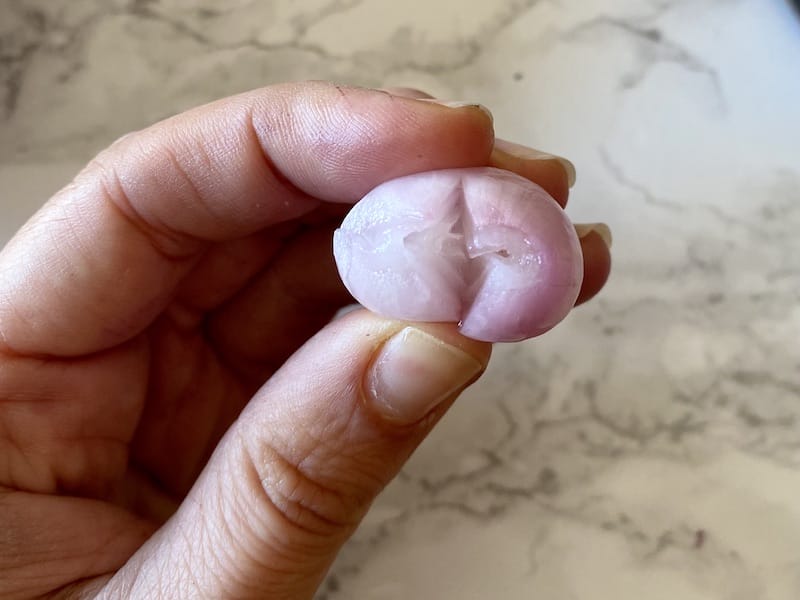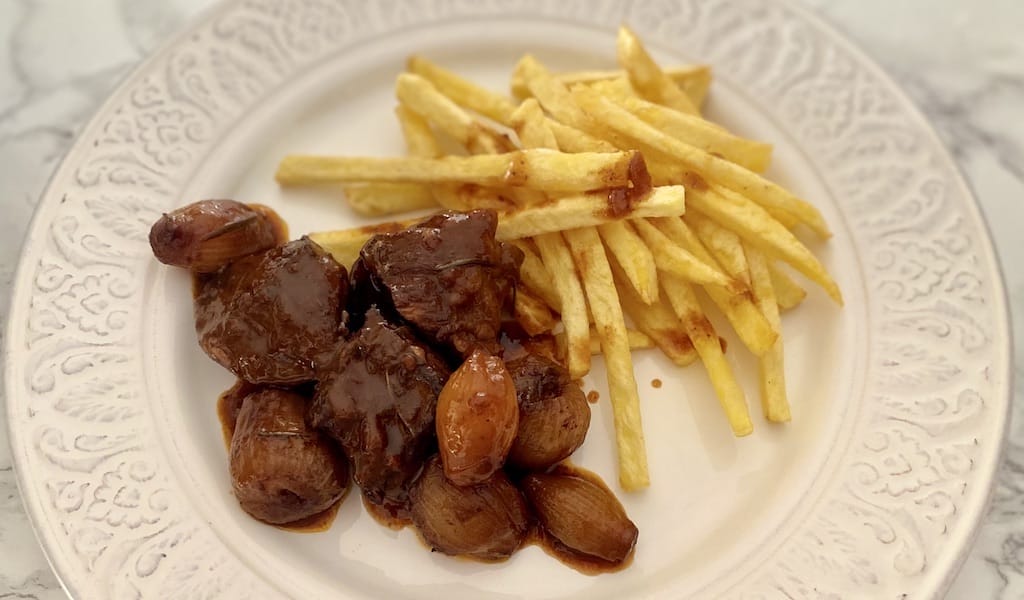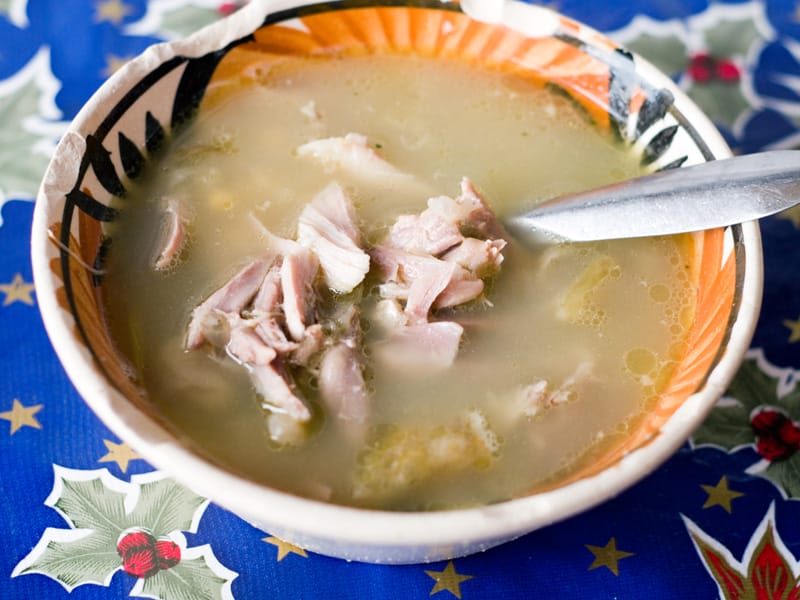Greek stifado is a special dish: It requires time to prepare but the result is succulent, rewarding and stomach-warming, like stews ought to be. Tender, juicy chunks of meat are patiently cooked at low heat amid a sea of small pearl onions in a rich red wine sauce flavored with warming spices and herbs, like allspice, cinnamon, cloves, bay leaves and rosemary, that I tend to associate more with the winter season. By the end, the onions go glossy and caramelized in this delicious sauce and the pieces of meat are fork tender.
The word stifado derives from the ancient Greek word tyfos (τύφος), which means steam. This is the root for the Latin word estufare, from which the Italian stufato (or Venetian stufado), the Italian word for stew, was born.
The dish as we know it today in Greece is traced back to the 13th century, when the Venetians introduced it to the areas they had conquered. One of the most classic versions of stifado is made with rabbit, and it’s absolutely delightful. Other popular takes are made with beef or veal, although it is also commonly made with octopus.

I personally think of stifado as a winter dish, but in Greece it is traditionally associated with a large festival that takes place on the island of Euboea every year on August 15 (the Assumption of Mary) – an important holiday across the country. In a village called Oxylithos, on the eastern side of the island, a huge celebration takes place at the 13th-century Byzantine church known as Panayia Pertiotissa or Panayia Chatirianissa (Panayia is the Greek word for “Virgin Mary”). Dozens of huge pots – often more than 170 in total – are lined outdoors to prepare traditional stifado.
On the preceding day, locals offer all the ingredients: olive oil, meat, wine, onions and tomatoes. That evening, young men and women from the village gather to begin the preparations. Later, once night falls, they start cooking the stifado over a wood-burning fire, following the instructions of the village elders. The food cooks over low heat all night and is served the next day after the church service to all the people present, locals and visitors alike.
Smaller festivals, where the same dish is made, also take place on that day in the nearby villages of Kalimeriani and Potamia. A similar tradition also takes place on June 29 in Spata, near the Athens airport, to honor Saints Peter and Paul – locals come together to prepare the recipe, cleaning hundreds of little onions, slow cooking the stifado overnight over a wood-burning fire and then dishing it up after the religious service the next day.
My stifado recipe uses beef, and I don’t cook it overnight, nor do I have the space to light a fire in my apartment! Instead I make it on the stovetop, as almost everyone does here outside of the festivals. It’s best to choose a cut that is ideal for stews and can be cooked at low heat for a long period of time, such as chuck or low rump, which should be cut into smaller chunks. I love using rosemary along with the bay leaves, although it’s not necessary. My absolute favorite side to stifado are hand-cut fried potatoes – soaking them in the delicious sauce brings back hundreds of my childhood memories. The dish is versatile, however, and also pairs well with mashed potatoes, pasta or even rice.
Stifado
4-6 servings
1 kg beef for stews like chuck or low rump, cut into 7×5 cm chunks
1 kg pearl onions
350 ml dry red wine
60 ml balsamic vinegar
200 gr mavrodaphne (or another sweet red wine)
120 ml olive oil
5 bay leaves
1 ½ tbsp dried rosemary
1 large onion, chopped
2 garlic cloves, chopped
1 cinnamon stick
10 whole allspice
¼ tsp ground clove
200 gr fresh ripe tomato, peeled, seeded and chopped (or chopped canned tomatoes)
5 tsp tomato puree
Salt
Freshly ground black pepper
½ cup boiling water

To peel the pearl onions more easily, place them in a large basin and pour boiling water over them, enough to cover them. Let stand for 30 minutes and then, using a paring knife, start peeling them carefully. Slice off the bottom part of each onion and squeeze it carefully so that the onion slips off its skin (this should happen very easily, if not let them stand in boiling water a bit longer). Be gentle, as you want to keep the onions whole and round.
Place a large wide pot on medium high heat. Pour in the olive oil and brown the meat on all sides. Remove the meat onto a platter and set aside. In the same pot, sauté the chopped onion until soft and glossy. Add in the garlic, bay leaves, cinnamon, allspice and clove, season with salt and pepper, and stir for about a minute. Add in the pearl onions and stir until they all look glossy. Return the meat back into the pot and stir gently. Pour in the balsamic vinegar, give it another stir, and add in the wines. Bring the heat down to medium low and add the chopped tomatoes and the puree. Season with some extra salt and pepper to taste, add about half a cup of boiling water, and as soon as it starts simmering again cover and bring the heat down to low. Let it slow cook for about 1.5 hours until the sauce has reduced and thickened. Adjust seasoning if necessary and remove from heat.
Serve with hand-cut fried potatoes or another side of your choice, such as mashed potatoes, pasta or rice. You may serve topped with grated cheese like kefalotyri or pecorino, and freshly ground black pepper.
To convert metric measurements to US and British kitchen units, click here.
 April 2, 2024 Grandma’s Folar Recipe
April 2, 2024 Grandma’s Folar Recipe
Folar is the generic name given to traditional Easter sweet bread in Portugal. Making it […] Posted in Lisbon January 17, 2024 Recipe
January 17, 2024 Recipe
I can’t think of a more comforting dish than soup. It can be as simple or complex as you […] Posted in Athens January 16, 2024 Caldos de Gallina Luis
January 16, 2024 Caldos de Gallina Luis
Caldos de Gallina Luis – which a friend had been raving about to us for months before we […] Posted in Mexico City
Published on January 28, 2021
Related stories
April 2, 2024
LisbonFolar is the generic name given to traditional Easter sweet bread in Portugal. Making it from scratch is somewhat of a long process, but being confined due to the coronavirus crisis, we seem to have a bit more time on our hands than expected. My family’s folar recipe is from my grandmother Felismina, who was…
January 17, 2024
AthensI can’t think of a more comforting dish than soup. It can be as simple or complex as you wish, and as cheap or expensive as you can afford. Just open your fridge or pantry, and you’re sure to find something to turn into a liquid meal – vegetables, herbs, spices, meat, poultry, seafood, grains, legumes……
January 16, 2024
Mexico CityCaldos de Gallina Luis – which a friend had been raving about to us for months before we finally made it there – is essentially a street food stand that has been trussed up to look more like a sidewalk café. Just a short walk from the Insurgentes metro stop, the venue is located on…


















































































